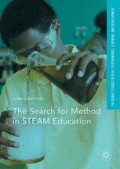Abstract
In this chapter, I describe the conference where I met scientists who are doing interdisciplinary work using the arts in teaching Science. A conversation with an architect who plays with the building blocks of materials and biology will help with understanding different aspects of interdisciplinary work in teaching the STEAM disciplines.
Access this chapter
Tax calculation will be finalised at checkout
Purchases are for personal use only
References
Casakin, H., Van Timmeren, A., & Badke-Schaub, P. (2016). Approaches in design education: The role of patterns and scenarios in the design studio. Problems of Education in the 21st Century, 69 (Caliksan, 2012), 6–21.
Deleuze, G., Guattari, F., & Stivale, C. (1984). Concrete rules and abstract machines. SubStance, 13(3/4), 7–19. Retrieved from http://doi.org/10.2307/3684771.
Dym, C. L., Agogino, A. M., Eris, O., Frey, D. D., & Leifer, L. J. (2005). Engineering design thinking, teaching, and learning. Journal of Engineering Education, 94(1), 103–119. Retrieved from doi: 10.1002/j.2168-9830.2005.tb00832.x.
Holzman, L. (1999). Life as performance. In L. Holzman (Ed.), Performing psychology: A postmodern culture of the mind. New York, London: Routledge.
Holzman, L. (2009). Vygotsky at work and play. New York, NY: Routledge.
Johns, G., & Mentzer, N. (2016). STEM integration. Technology and Engineering Teacher, (November), 13–18.
Ledford, B. Y. H. (2015, September 17). Team science. Nature, 525, 308–311.
Lottero-Perdue, P., Bowditch, M., Kagan, M., Robinson-cheek, L., & Webb, T. (2016). An engineering design process for trying (again) to engineer an egg package. Science and Children, (November), 70–78.
Newman, F., & Holzman, L. (1997). The End of knowing: A new developmental way of learning. New York, NY: Routledge.
Porter, A. L., & Rafols, I. (2009). Is science becoming more interdisciplinary? Measuring and mapping six research fields over time. Scientometrics, 81(3), 719–745. Retrieved from http://doi.org/10.1007/s11192-008-2197-2.
Perbellini, M., & Pongratz, C. (2015). Digital media for design. CA: Cognella Academic Publishing.
Razzouk, R., & Shute, V. (2012). What is design thinking and why is it important? Review of Educational Research, 82(3), 330–348. Retrieved from http://doi.org/10.3102/0034654312457429.
Rylance, R. (2015, September 17). Grant giving: Global funders to focus on interdisciplinarity. Nature, 525, 313–315. Retrieved from http://doi.org/10.1038/525313a.
Sugata Mitra, (2005). Self organising systems for mass computer literacy: Findings from the ‘hole in the wall’ experiments. International Journal of Development Issues, 4(1), 71–81. doi: 10.1108/eb045849.
Author information
Authors and Affiliations
Corresponding author
Rights and permissions
Copyright information
© 2017 The Author(s)
About this chapter
Cite this chapter
Martinez, J.E. (2017). Science. In: The Search for Method in STEAM Education. Palgrave Studies In Play, Performance, Learning, and Development. Palgrave Macmillan, Cham. https://doi.org/10.1007/978-3-319-55822-6_3
Download citation
DOI: https://doi.org/10.1007/978-3-319-55822-6_3
Published:
Publisher Name: Palgrave Macmillan, Cham
Print ISBN: 978-3-319-55821-9
Online ISBN: 978-3-319-55822-6
eBook Packages: EducationEducation (R0)

